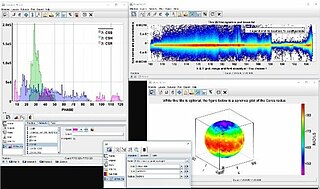
IRAF is a collection of software written at the National Optical Astronomy Observatory (NOAO) geared towards the reduction of astronomical images and spectra in pixel array form. This is primarily data taken from imaging array detectors such as CCDs. It is available for all major operating systems for mainframes and desktop computers. IRAF was designed cross-platform, supporting VMS and UNIX-like operating systems. Use on Microsoft Windows was made possible by Cygwin in earlier versions, and can be today done with the Windows Subsystem for Linux. Today, it is primarily used on macOS and Linux.

A robotic telescope is an astronomical telescope and detector system that makes observations without the intervention of a human. In astronomical disciplines, a telescope qualifies as robotic if it makes those observations without being operated by a human, even if a human has to initiate the observations at the beginning of the night or end them in the morning. It may have software agents using artificial intelligence that assist in various ways such as automatic scheduling. A robotic telescope is distinct from a remote telescope, though an instrument can be both robotic and remote.

The Inter-University Centre for Astronomy and Astrophysics (IUCAA) is an autonomous institution set up by the University Grants Commission of India to promote nucleation and growth of active groups in astronomy and astrophysics in Indian universities. IUCAA is located in the University of Pune campus next to the National Centre for Radio Astrophysics, which operates the Giant Metrewave Radio Telescope. IUCAA has a campus designed by Indian architect Charles Correa.

The National Centre for Radio Astrophysics is a research institution in India in the field of radio astronomy is located in the Pune University Campus, is part of the Tata Institute of Fundamental Research, Mumbai, India. NCRA has an active research program in many areas of Astronomy and Astrophysics, which includes studies of the Sun, Interplanetary scintillations, pulsars, the Interstellar medium, Active galaxies and cosmology and particularly in the specialized field of Radio Astronomy and Radio instrumentation. NCRA also provides exciting opportunities and challenges in engineering fields such as analog and digital electronics, signal processing, antenna design, telecommunication and software development.

Aladin is an interactive software sky atlas, created in France. It allows the user to visualize digitized astronomical images, superimpose entries from astronomical catalogues or databases, and interactively access related data and information from the SIMBAD database, the VizieR service and other archives for all known sources in the field.

The Starlink Project, referred to by users as Starlink and by developers as simply The Project, was a UK astronomical computing project which supplied general-purpose data reduction software. Until the late 1990s, it also supplied computing hardware and system administration personnel to UK astronomical institutes. In the former respect, it was analogous to the US IRAF project.
The UCL Mullard Space Science Laboratory (MSSL) is the United Kingdom's largest university space research group. MSSL is part of the Department of Space and Climate Physics at University College London (UCL), one of the first universities in the world to conduct space research. Since its establishment, MSSL has participated in 35 satellite missions, 10 of which are currently in operation, and in over 200 sounding rocket experiments.
The International Virtual Observatory Alliance (IVOA) is a worldwide scientific organisation formed in June 2002. Its mission is to facilitate international coordination and collaboration necessary for enabling global and integrated access to data gathered by astronomical observatories. An information system allowing such an access is called a virtual observatory. The main task of the organisation so far has focused on defining standards to ensure interoperability of the different virtual observatory projects already existing or in development.
The US National Virtual Observatory'-NVO- was conceived to allow scientists to access data from multiple astronomical observatories, including ground and space-based facilities, through a single portal. Originally, the National Science Foundation (NSF) funded the information technology research that created the basic NVO infrastructure through a multi-organization collaborative effort. The NVO was more than a “digital library”; it was a vibrant, growing online research facility akin to a bricks-and-mortar observatory for professional astronomers.
The D-Grid Initiative was a government project to fund computer infrastructure for education and research (e-Science) in Germany. It uses the term grid computing. D-Grid started September 1, 2005 with six community projects and an integration project (DGI) as well as several partner projects.
A virtual observatory (VO) is a collection of interoperating data archives and software tools which utilize the internet to form a scientific research environment in which astronomical research programs can be conducted.

AstroSat is India's first dedicated multi-wavelength space telescope. It was launched on a PSLV-XL on 28 September 2015. With the success of this satellite, ISRO has proposed launching AstroSat-2 as a successor for AstroSat.

WorldWide Telescope (WWT) is an open-source set of applications, data and cloud services, originally created by Microsoft Research but now an open source project hosted on GitHub. The .NET Foundation holds the copyright and the project is managed by the American Astronomical Society and has been supported by grants from the Moore Foundation and National Science Foundation. WWT displays astronomical, earth and planetary data allowing visual navigation through the 3-dimensional (3D) Universe. Users are able to navigate the sky by panning and zooming, or explore the 3D universe from the surface of Earth to past the Cosmic microwave background (CMB), viewing both visual imagery and scientific data about that area and the objects in it. Data is curated from hundreds of different data sources, but its open data nature allows users to explore any third party data that conforms to a WWT supported format. With the rich source of multi-spectral all-sky images it is possible to view the sky in many wavelengths of light. The software utilizes Microsoft's Visual Experience Engine technologies to function. WWT can also be used to visualize arbitrary or abstract data sets and time series data.

IUCAA Girawali Observatory is an optical astronomy observatory run by the Inter-University Centre for Astronomy and Astrophysics (IUCAA), Pune, India. The Observatory is located about 80 km from Pune, off the Pune Nashik Highway in Girawali.

Astroinformatics is an interdisciplinary field of study involving the combination of astronomy, data science, machine learning, informatics, and information/communications technologies. The field is closely related to astrostatistics.
INDIGO or IndIGO is a consortium of Indian gravitational-wave physicists. It is an initiative to set up advanced experimental facilities for a multi-institutional observatory project in gravitational-wave astronomy to be located near Aundha Nagnath, Hingoli District, Maharashtra, India. Predicted date of commission is in 2030.

TOPCAT is an interactive graphical viewer and editor for tabular data. Although a general purpose tool capable of handling large and sparse datasets with correlation functionality its specialist application area is astronomy and it was initially designed to support virtual observatories. It is able to handle several digital file formats including FITS which is in common use in astronomy. The Acronym TOPCAT derives from Tool for OPerations on Catalogues And Tables.

Astropy is a collection of software packages written in the Python programming language and designed for use in astronomy. The software is a single, free, core package for astronomical utilities due to the increasingly widespread usage of Python by astronomers, and to foster interoperability between various extant Python astronomy packages. Astropy is included in several large Python distributions; it is part of package managers for Linux and macOS, the Anaconda Python Distribution, Enthought Canopy and Ureka.

INFLIBNET Centre is an Inter-University Centre of the University Grants Commission (India) under the Ministry of Education (India). The organisation promotes and facilitates libraries and information resources for Indian further education. Its premises are in Gandhinagar, Gujarat.

Ajit Kembhavi is an Indian astrophysicist. He is presently a Professor Emeritus at the Inter-University Centre for Astronomy and Astrophysics, (IUCAA) at Pune, India, of which he was also a founder member. He also serves as a Vice President of the International Astronomical Union. He is the Principal Investigator of Pune Knowledge Cluster along with Professor L. S. Shashidhara.













